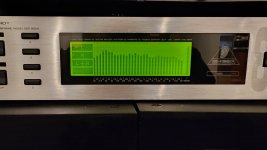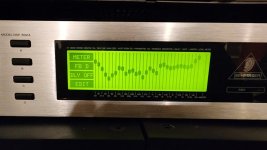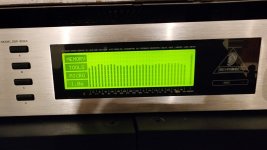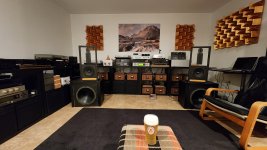As with most manufacturers, their specs have no details as to conditions, variance or really anything technically useful. They just make up numbers like Scientology does about it's membership, and hope most people never question them about it. 😉
It is not first suspicious claim but there are some usable tricks, like use much higher sensitivity woofers than mids. When using woofers ctc within 1/4 wl there is +6dB, if using dipole peak in response there is 3-6 dB more and if woofers sensitivity is 10 dB higher than mids and tweeters there are enough decibels to equalize woofers.
Anyway, IMHO, they hardly could play below 40ies
Anyway, IMHO, they hardly could play below 40ies
Actually, current drive is bad for that distortion which is due to Bl(x), i.e. variation in motor strength with excursion. That's because the resulting variation in back-emf works in concert with voltage-drive to counteract this source of distortion (so when Bl varies, back-emf varies, and therefore drive current). In practice, this seems to be a major source of distortion, because Bl tends to vary a lot as the voice-coil moves along the magnetic gap...With a big inductivity on the woofer they make it current driven. Minimizes some distortion.
Current drive would be good for distortion due to Le(x) and Le(i), i.e. variation in voice-coil inductance with excursion and/or drive current - but this isn't very relevant here because its effects are mostly limited to higher frequencies. Which may be why inductive drive is found to be offer "sweeter" mid-range in this forum's Manzanitas (at least that's the conclusion I'm drawing anyway).
As for the OP's naked 12" drivers example, my experience is that using a pair of naked 12" bass drivers and mounting them close to the floor gives you several advantages over a notional single driver in free air, and makes them quite viable. Well, down to 30-40Hz anyway. But then I suppose my room is pretty much ideal for OB bass, being longish and fairly narrow...
Mounting the woofers close to the floor will avoid the typical “floor bounce” comb filter that typically happens around 200 Hz. I made a mid bass dipole using a single 8” for a Magnepan 1.6, that cover the 150 to 400 Hz range. Worked far better mounted very low, compared to at typical listening height if 90-100 cm above the floor.

An even better solution is to make it a line source, like my own mid bass dipoles with four 12”
An even better solution is to make it a line source, like my own mid bass dipoles with four 12”
@ StigErik
Take care with this Linkwitz spreadsheet - D is not the Diameter of the baffle, but more or less it's radius, or as stated, the effective path difference for a point source. So you should input 150mm instead of 300mm into your spreadsheet. This spreadsheet was published by Linkwitz on his website in an early version related to a section called "Open-baffle Loudspeakers". Have a look there for the meaning of D.
Later on Linkwitz published a more elaborated chapter about "Radiations from a rigid circular piston in a finite circular open baffle". Taking your values (Diam=300mm / SD=1060) into the resulting simulation of this later section, then the SPL of this speaker e.g. at 40Hz will result in some
If you take these graphs, then you end up with the following values (taking an overall radius/pathdifference D=160mm):
40Hz: 110dB - 30dB = 80dB
100Hz: 126dB - 16dB = 110dB
Horizontal constant directivity may reach up to some 630Hz.
And take this with a grain of salt - It's nothing but simulations, models and approximations.

Take care with this Linkwitz spreadsheet - D is not the Diameter of the baffle, but more or less it's radius, or as stated, the effective path difference for a point source. So you should input 150mm instead of 300mm into your spreadsheet. This spreadsheet was published by Linkwitz on his website in an early version related to a section called "Open-baffle Loudspeakers". Have a look there for the meaning of D.
Later on Linkwitz published a more elaborated chapter about "Radiations from a rigid circular piston in a finite circular open baffle". Taking your values (Diam=300mm / SD=1060) into the resulting simulation of this later section, then the SPL of this speaker e.g. at 40Hz will result in some
If you take these graphs, then you end up with the following values (taking an overall radius/pathdifference D=160mm):
40Hz: 110dB - 30dB = 80dB
100Hz: 126dB - 16dB = 110dB
Horizontal constant directivity may reach up to some 630Hz.
And take this with a grain of salt - It's nothing but simulations, models and approximations.
Last edited:
Hi, it would need very high woofer height and short listening distance to get floor reflection dip down to 200Hz. For example 90cm height for woofer and 1.5m listening distance would do it, assuming 90cm listening height. Interference dip would mean half wavelength path length difference between direct and reflected sound and for 200Hz that would be around 85cm.Mounting the woofers close to the floor will avoid the typical “floor bounce” comb filter that typically happens around 200 Hz. I made a mid bass dipole using a single 8” for a Magnepan 1.6, that cover the 150 to 400 Hz range. Worked far better mounted very low, compared to at typical listening height if 90-100 cm above the floor.
View attachment 1186306
An even better solution is to make it a line source, like my own mid bass dipoles with four 12”
With 3m listening distance floor reflection is likely the shortest of all six first room boundary reflection path lengths making it the highest in frequency.
I don't know which is more typical listening distance, but since we all have varying distances thought to write about it so people check them selves with their setups and not blindly blame the floor bounce 🙂 Positions vary, which affects path lengths of first reflections, which is the cause of interference at listening spot.
If one has a severe dip in response I think its more likely multiple early reflections with similar path lengths that pile up and cause a dip. Another woofer about at any position would help to fill that in, or if its a single woofer perhaps all the 6 path lengths now more randomized and dip eases out.
Well, if woofer near floor fixes it then its all good 🙂
esit. play around with this with Vituixcad. Open the program, hook the ideal driver with a wire, click the room -tab and adjust away, watch the yellow PIR curve.
Last edited:
Have you heard these 1030 FPS drivers? I have not heard of them before. Better than the GRS planar mids?https://www.monoandstereo.com/2021/12/io-design-naked-speakers.html?m=1
12" woofers per this link. And I'm certain those mids are the 1030 driver that FPS makes.
Cool pics. > I like hardware based analyzer/equalizers. It reminds me of a Behringer I once used in a workplace.Before eq, eq required, after...quite happy with the response in the listening chair.
What is it?
What is the amp in your main system?
CHEERS🙂
I have not. Thought about purchasing them when on sale at parts Express, but never pulled the trigger, unfortunately.Have you heard these 1030 FPS drivers? I have not heard of them before. Better than the GRS planar mids?
It is behringer ultracurve.Cool pics. > I like hardware based analyzer/equalizers. It reminds me of a Behringer I once used in a workplace.
What is it?
What is the amp in your main system?
CHEERS🙂
Amps? I use biamping with simple active crossover. Bass duties by various plate amps. Top by various amps on rotation: J2, wolverine, AlephJ, M2, F5, F1J, AN39, F3, F4, JLH and many other chip based permutations.
Last edited:
I'd like, too.
But the states are far far away.
Interesting to hear different amps. Rarely someone knows why they sound different.
But the states are far far away.
Interesting to hear different amps. Rarely someone knows why they sound different.
I have a question about U-frame and H-frame design. Assume you have a U-frame or H-frame design that is producing bass response you are happy with. And that design is 7” deep sides (on one side for a U and both sides of the baffle for an H). What is the impact on response (generally) if you change the shape, but keep total volume the same? See the example image: 1 is normal, 2 & 3 are shape modifications which keep volume consistent.
Attachments
Nearly what ever OB bass speaker need active correction to play bass. If driver have big Xmax and high nominal power, only then proper correction can be made. Corrected OB play very good bass. Most significant difference of U- and H-frame is that U-frame is nearly omnidirectional at first dipole peak, H-frame is dipole in full frequency range it produces. With same on axis FR U-frame can be half size of H-frame. Inclined H-frame had nearly no sense other had cosmetical and FR is determined by the smallest front and back separation length what frame have.
I am going to try 4 inch full range open baffle with tube amp crossed at 200hz with 8 inch sub tube tuned for the lows.
- Home
- Loudspeakers
- Multi-Way
- All open baffle




